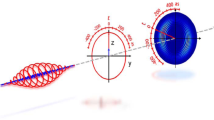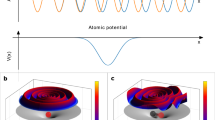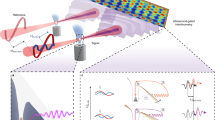Abstract
The tunnelling of a particle through a barrier is one of the most fundamental and ubiquitous quantum processes. When induced by an intense laser field, electron tunnelling from atoms and molecules initiates a broad range of phenomena such as the generation of attosecond pulses1, laser-induced electron diffraction2,3 and holography2,4. These processes evolve on the attosecond timescale (1 attosecond ≡ 1 as = 10−18 seconds) and are well suited to the investigation of a general issue much debated since the early days of quantum mechanics5,6,7—the link between the tunnelling of an electron through a barrier and its dynamics outside the barrier. Previous experiments have measured tunnelling rates with attosecond time resolution8 and tunnelling delay times9. Here we study laser-induced tunnelling by using a weak probe field to steer the tunnelled electron in the lateral direction and then monitor the effect on the attosecond light bursts emitted when the liberated electron re-encounters the parent ion10. We show that this approach allows us to measure the time at which the electron exits from the tunnelling barrier. We demonstrate the high sensitivity of the measurement by detecting subtle delays in ionization times from two orbitals of a carbon dioxide molecule. Measurement of the tunnelling process is essential for all attosecond experiments where strong-field ionization initiates ultrafast dynamics10. Our approach provides a general tool for time-resolving multi-electron rearrangements in atoms and molecules11,12,13—one of the key challenges in ultrafast science.
This is a preview of subscription content, access via your institution
Access options
Subscribe to this journal
Receive 51 print issues and online access
$199.00 per year
only $3.90 per issue
Buy this article
- Purchase on Springer Link
- Instant access to full article PDF
Prices may be subject to local taxes which are calculated during checkout




Similar content being viewed by others
References
Hentschel, M. et al. Attosecond metrology. Nature 414, 509–513 (2001)
Spanner, M., Smirnova, O., Corkum, P. B., Ivanov, M. & Yu Reading diffraction images in strong field ionization of diatomic molecules. J. Phys. B 37, L243–L250 (2004)
Meckel, M. et al. Laser-induced electron tunneling and diffraction. Science 320, 1478–1482 (2008)
Huismans, Y. et al. Time-resolved holography with photoelectron waves. Science 331, 61–64 (2011)
Büttiker, M. & Landauer, R. Traversal time for tunneling. Phys. Rev. Lett. 49, 1739–1742 (1982)
Steinberg, M. A., Kwiat, P. G. & Chiao, R. Y. Measurement of the single-photon tunnelling time. Phys. Rev. Lett. 71, 708–711 (1993)
Landauer, R. & Martin Barrier interaction time in tunneling. Rev. Mod. Phys. 66, 217–228 (1994)
Uiberacker, M. et al. Attosecond real-time observation of electron tunnelling in atoms. Nature 446, 627–632 (2007)
Eckle, P. et al. Attosecond ionization and tunneling delay time measurements in helium. Science 322, 1525–1529 (2008)
Krausz, F., Ivanov, M. & Yu Attosecond physics. Rev. Mod. Phys. 81, 163–234 (2009)
Schultze, M. et al. Delay in photoemission. Science 328, 1658–1662 (2010)
Smirnova, O. et al. High harmonic interferometry of multi-electron dynamics in molecules. Nature 460, 972–977 (2009)
Walters, Z. B. & Smirnova, O. Attosecond correlation dynamics during electron tunnelling from molecules. J. Phys. B 43, 161002 (2010)
Keldysh, L. V. Ionization in the field of a strong electromagnetic wave. Sov. Phys. JETP 20, 1307–1314 (1965)
Perelomov, M. A., Popov, S. V. & Terent’ev, M. V. Ionization of atoms in an alternating electric field: II. Sov. Phys. JETP 24, 207 (1967)
Corkum, P. B. Plasma perspective on strong field multiphoton ionization. Phys. Rev. Lett. 71, 1994–1997 (1993)
Salières, P. et al. Feynman’s path-integral approach for intense-laser-atom interactions. Science 292, 902–905 (2001)
Pfeiffer, A. N. et al. Attoclock reveals natural coordinates of the laser-induced tunnelling current flow in atoms. Nature Phys. 8, 76–80 (2012)
Baker, S. et al. Probing proton dynamics in molecules on an attosecond time scale. Science 312, 424–427 (2006)
Mairesse, Y. et al. Attosecond synchronization of high-harmonic soft X-rays. Science 302, 1540–1543 (2003)
Dudovich, N. et al. Measuring and controlling the birth of attosecond XUV pulses. Nature Phys. 2, 781–786 (2006)
Chirilă, C. C., Dreissigacker, I., van der Zwan, E. V. & Lein, M. Emission times in high-order harmonic generation. Phys. Rev. A 81, 033412 (2010)
Shafir, D. et al. Atomic wavefunctions probed through strong-field light-matter interaction. Nature Phys. 5, 412–416 (2009)
Lewenstein, M., Balcou, Ivanov, M., Yu, L’Huillier, A. & Corkum, P. B. Theory of high-harmonic generation by low-frequency laser fields. Phys. Rev. A 49, 2117–2132 (1994)
Dahlström, J. M., L’Huillier, A. & Mauritsson, J. Quantum mechanical approach to probing the birth of attosecond pulses using a two-colour field. J. Phys. B 44, 095602 (2011)
Haessler, S. et al. Attosecond imaging of molecular electronic wavepackets. Nature Phys. 6, 200–206 (2010)
Murray, R., Spanner, M., Patchkovskii, S., Ivanov, M. & Yu Tunnel ionization of molecules and orbital imaging. Phys. Rev. Lett. 106, 173001 (2011)
Tong, X. M., Zhao, Z. X. & Lin, C. D. Probing molecular dynamics at attosecond resolution with femtosecond laser pulses. Phys. Rev. Lett. 91, 233203 (2003)
Niikura, H. et al. Probing molecular dynamics with attosecond resolution using correlated wave packet pairs. Nature 421, 826–829 (2003)
Mairesse, Y. et al. High harmonic spectroscopy of multichannel dynamics in strong-field ionization. Phys. Rev. Lett. 104, 213601 (2010)
Acknowledgements
N.D. acknowledges the Minerva Foundation, the Israeli Science Foundation and the Crown Center of Photonics for financial support. N.D. and O.S. acknowledge the German-Israeli Foundation, and D.S. acknowledges support from the Converging Technologies Fellowship of the Israeli Ministry of Science. H.S. is supported by the Adams Fellowship Program of the Israel Academy of Sciences and Humanities. O.S. acknowledges the support of the DFG grant Sm292/2-1, and M.Yu.I. acknowledges the support of the EPSRC programme grant EP/I032517/1. Y.M. acknowledges financial support from the ANR (ANR-08-JCJC-0029 HarModyn) and the Conseil Regional d’Aquitaine (20091304003 AttoMol). M.I. acknowledges support of the EPSRC Programme Grant EP/I0325171/1.
Author information
Authors and Affiliations
Contributions
D.S., H.S., B.D.B., M.D. and N.D. designed, performed and analysed the experiment. Y.M. contributed to the analysis. M.Yu.I. and O.S. developed the theory and performed the calculations of harmonic spectra. S.P. provided the quantum chemistry input for the calculations. All authors contributed to writing the manuscript.
Corresponding author
Ethics declarations
Competing interests
The authors declare no competing financial interests.
Supplementary information
Supplementary Information
This file contains Supplementary Text, Supplementary Data, Supplementary Figures 1-2 and Supplementary References. (PDF 433 kb)
Rights and permissions
About this article
Cite this article
Shafir, D., Soifer, H., Bruner, B. et al. Resolving the time when an electron exits a tunnelling barrier. Nature 485, 343–346 (2012). https://doi.org/10.1038/nature11025
Received:
Accepted:
Published:
Issue Date:
DOI: https://doi.org/10.1038/nature11025
This article is cited by
-
Observation of interband Berry phase in laser-driven crystals
Nature (2024)
-
Attosecond field emission
Nature (2023)
-
Simulation of laser-induced tunnel ionization based on a curved waveguide
Scientific Reports (2023)
-
Tracing attosecond electron emission from a nanometric metal tip
Nature (2023)
-
A look under the tunnelling barrier via attosecond-gated interferometry
Nature Photonics (2022)
Comments
By submitting a comment you agree to abide by our Terms and Community Guidelines. If you find something abusive or that does not comply with our terms or guidelines please flag it as inappropriate.



